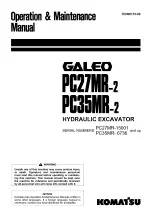
00-30
PC128US-8
00 Index and foreword
How to read electric wire code
How to read electric wire code
1
a
The information about the wires unique to each machine model is described in Troubleshooting section,
Relational information of troubleshooting.
In the electric circuit diagram, the material, thickness, and color of each electric wire are indicated by sym-
bols. The electric wire code is helpful in understanding the electric circuit diagram.
1.
Type, symbol, and material
AV and AVS are different in only thickness and outside diameter of the cover. AEX is similar to AV in
thickness and outside diameter of AEX and different from AV and AVS in material of the cover.
Example: AEX
0.85
L - - - Indicates blue, heat-resistant, low-voltage wire for automobile, having nomi-
nal No. of 0.85
Indicates color of wire by color code.
Color codes are shown in Table 3.
Indicates size of wire by nominal No.
Size (Nominal No.) is shown in Table 2.
Indicates type of wire by symbol.
Type, symbol, and material of wire are shown in Table 1.
(Since AV and AVS are classified by size (nominal No.), they are not indi-
cated.)
(Table 1)
Type
Sym-
bol
Material
Using
temperature
range (°C)
Example of use
Low-voltage
wire for
automobile
AV
Conduc-
tor
Annealed copper for elec-
tric appliance
–30 to +60
General wiring
(Nominal No. 5 and above)
Insulator
Soft polyvinyl chloride
Thin-cover
low-voltage
wire for
automobile
AVS
Conduc-
tor
Annealed copper for elec-
tric appliance
General wiring
(Nominal No. 3 and below)
Insulator
Soft polyvinyl chloride
Heat-resis-
tant low-volt-
age wire for
automobile
AEX
Conduc-
tor
Annealed copper for elec-
tric appliance
–50 to +110
General wiring in extremely
cold district, wiring at high-tem-
perature place
Insulator
Heat-resistant crosslinked
polyethylene































